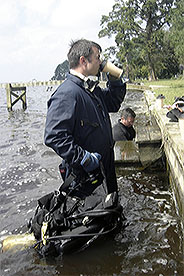ECU's 2006 Fall Field School
Project Journal
22 September 2006
By Tricia Dodds

By the end of the week, we have managed to make considerable progress on the Padgett vessel. Of course, we have experienced several “temporary delays” throughout the project, but we have overcome one obstacle after another and have basically met all of our goals on this project at least. We began the day by saying farewell to the dive barge since our current site is so shallow (sometimes only two feet in low tide!) and therefore not conducive to the dive barge. We actually enter and exit the water from shore and just use the skiff to hold the dredge equipment. Sometimes I feel a little weird putting on SCUBA gear when I’m only going to be diving two feet, but snorkels will not work and I cannot hold my breath for an hour yet. In regards to the dive barge, I managed to last through field school without falling off that unstable ladder, which I cannot say for all of our divers. At least we have all survived so far none the worse for wear aside from a few nasty bruises and sunburns-all sacrifices in the name of science.

Taking a much needed coffee break after a hard day's work.
The dredging is almost complete. I suppose that this means our sacrifice to the dredge gods was deemed acceptable. We finished dredging the port side (left side of a vessel when facing forward) and are making excellent progress on the starboard side (right side of a vessel when facing forward) as we continued dredging today. The starboard side is taking a little longer to remove the sand since it is more abundant here, but we are hoping to finish the dredging very soon if all goes well.
We also started hand mapping today! This is a huge victory since we have now officially begun recording the vessel. For hand mapping, we divide the vessel into two halves basically down the middle into the port and the starboard side using a metal baseline. Then we further divide the vessel into ten foot square sections across on either side of the baseline, and divers draw everything included in their squares. Hand mapping is two-dimensional, meaning that we draw everything looking directly down from a birdís eye view. The divers typically hover over the vessel to draw, suspended in the water almost as if they are weightless.

Slate with new Mylar taped to it for mapping.
We map by drawing underwater with pencils on Mylar sheets (basically waterproof paper) that are taped to slates. We reduce everything as we draw using a scale of 1 inch to 2 feet with the help of tape measures. The slate has grids with one inch squares that help us keep track of the placement of everything on the drawing in relation to the actual vessel. After the whole vessel has been mapped one section at a time, the drawings are put together like a mosaic. This whole process takes a little practice, but once you get the hang of it, hand mapping is actually quite fun. There is a real sense of accomplishment in seeing the finished drawn product.
The group has been working hard on the Padgett vessel for the past week, and our efforts have certainly paid off. I guess you could say that we ended the week with a bang. I am excited to see what we can learn about this vessel and the people associated with it as we continue our study of the site. We should complete the project by next week as scheduled, provided we do not experience too many more temporary delays. We shall have to see what fate has in store for us.

Drawing of a section of the Padgett vessel on Mylar.
For more information you can visit the ECU website at:
http://www.ecu.edu/maritime/index.htm
Return to Project Journal home page.

